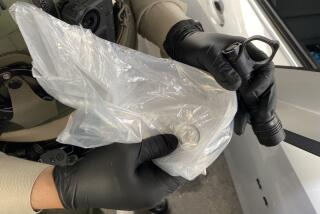On the Scent of Drunk Drivers
- Share via
The next time a police officer shines a flashlight in your face and starts asking questions, your answers may be more revealing than you think. Some officers are now armed with law enforcement’s hottest new weapon against drunk driving--the PAS III Sniffer, a hand-held alcohol-detection device concealed in a flashlight.
Able to estimate blood-alcohol content based on just four seconds of conversation, the technology takes the standard police sniff test to a more objective--and exact--level. Studies suggest that it nabs 20% to 30% more drunk drivers at a sobriety checkpoint than regular police procedures.
But what police and anti-drunk-driving groups see as a valuable tool, some civil liberties groups view as a dangerous erosion of personal privacy. For the Sniffer--unlike other field alcohol sensors--takes samples without the subject’s knowledge or consent.
“For many years, your privacy rights and the right of police to investigate was kept in balance by the available technology. That balance has been destroyed,” said Kent Willis, executive director of the American Civil Liberties Union of Virginia.
John W. Whitehead, director of the based Rutherford Institute, based in Charlottesville, Va., said the device may violate the Fourth Amendment’s ban on unreasonable searches. “To catch a possible drunk driver, do we throw the Constitution in the garbage can? I say no,” he said. “It assumes you’re guilty. It reverses the standard of proof. Why are they sniffing you if they don’t think you’re guilty? Next, they’re going to be sniffing for cigarettes.”
Last fall, Fairfax County, Va., police began using seven or eight of the $600 devices, mostly at sobriety checkpoints, although some officers have tried them on regular patrol, Lt. Dennis O’Neill said.
“So far they’ve worked really well,” he said. “It eliminates having to stick your face in the car to detect an odor of alcohol.”
Virginia State Police are testing about 15 Sniffers at sobriety checkpoints across the state.
A spokesman for the manufacturer, PAS Systems of Fredericksburg, Va., said the device has been sold to numerous police departments and schools in Southern California. Schools use Sniffers for “zero alcohol tolerance” enforcement at dances and athletic events, said spokesman Jeff Kelsey. The devices are so sensitive that “you can hold it right over a cup” and it will detect alcohol in a beverage, according to Kelsey.
Santa Fe Springs, which contracts police services to the Whittier Police Department, has one of the devices for use at DUI checkpoints. The Sniffer gives officers “a ballpark range of the BAC [blood alcohol content],” which is less specific than the reading from a device that a driver blows into, said traffic officer Robert Wood, who works out of Santa Fe Springs for the Whittier police. “It wouldn’t be a tool that I would base my whole case on.”
However, Wood said, it is especially valuable at DUI checkpoints where “we can’t have a person wait in line more than three minutes. Maybe you wouldn’t get your head all the way inside the car and catch that odor.” If a driver “is chewing gum or he’s got incense burning in the car,” the Sniffer should still pick up the scent of alcohol.
A public information officer for the Los Angeles Police Department said the LAPD does not have the devices.
When an officer pushes a button on the device, it samples the air in front of and around the subject and then estimates the blood-alcohol level. Results appear on a colored bar--green for sober, red for drunk. The manufacturer suggests having the subject state his name, address and date of birth to make sure the device gets a steady stream of breath.
Police use them only to single out drivers for the more usual field sobriety tests--walking a line, standing on one leg. If, based on the field test, the officer determines that there is reason to arrest a driver, another, more exact test of blood-alcohol content is performed.
The manufacturer has sold several thousand of the devices to police departments and school systems--for use in parking lots and at school events--since it bought the patent in 1993, said Jarel Kelsey, the company’s president.
Police and advocacy driving groups say the device, which also comes in a clipboard version for daytime use, adds valuable precision to the difficult task of catching drunk drivers.
According to a 1993 study conducted in Fairfax by the Insurance Institute of Highway Safety, police checkpoints catch only 55% of drivers with blood-alcohol contents of 0.10%. The legal limit for driving is 0.08% in Virginia, the same as in California.
When officers are equipped with passive alcohol sensors such as the Sniffer, the drunk-driver detection rate rises to 71%, according to the study.
“People who were driving drunk were able to brace themselves up and have a 50-50 chance of getting through a checkpoint. That’s what got us interested in the technology,” said Tim Hoyt, vice president of safety at Nationwide Insurance, which has donated several hundred of the devices to police departments across the country.
Schools in the Chicago area use the device, and the Texas Alcoholic Beverage Commission is using it at parties and bars where underage drinking is suspected.
There never has been a court challenge to the Sniffer, Kelsey said. He argues, and some legal analysts agree, that the device would survive such a challenge because it simply tests air after it has left the driver’s body and the results are not admissible as evidence of guilt in court.
In the end, University of Pennsylvania law professor Anita Allen-Castellito said, publicity may help resolve the problem.
“What’s troubling is that it is surreptitious,” she said. “But once folks know that flashlights are also alcohol sensors, it is better than police smelling you because it is more objective.”
*
Times staff writer Beverly Beyette contributed to this report.
More to Read
Sign up for Essential California
The most important California stories and recommendations in your inbox every morning.
You may occasionally receive promotional content from the Los Angeles Times.










